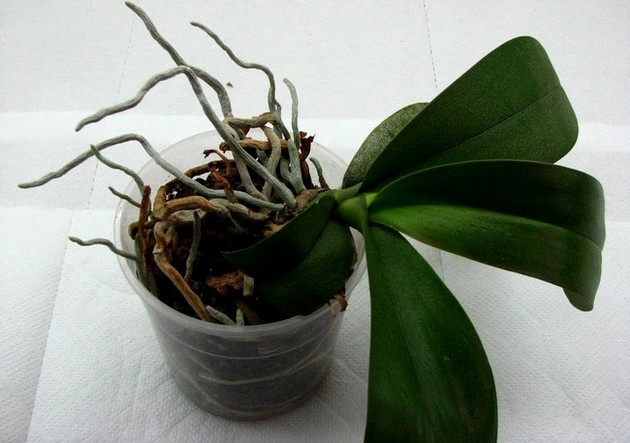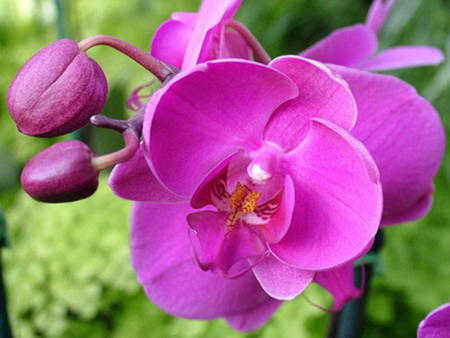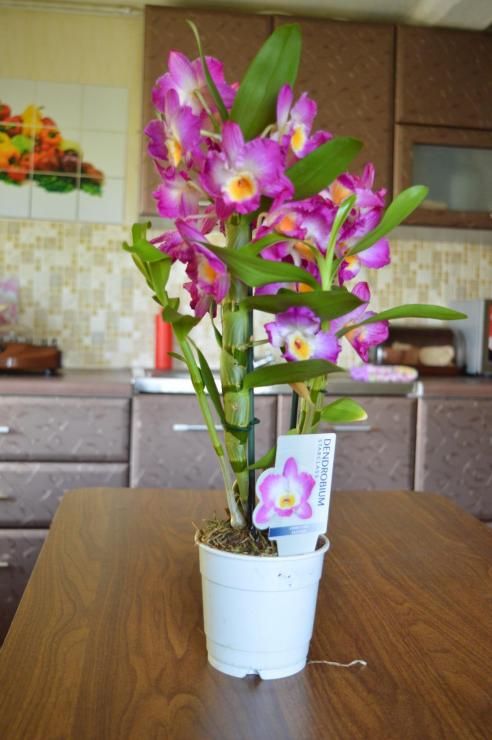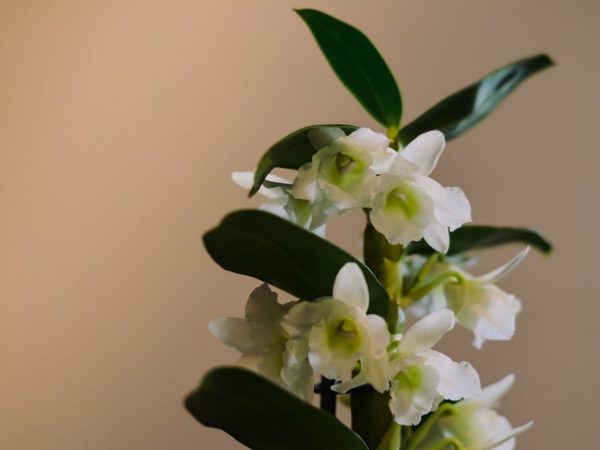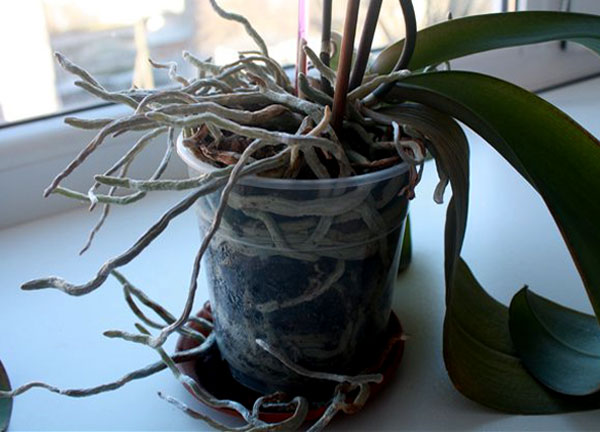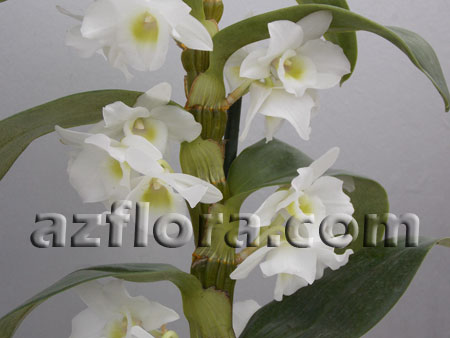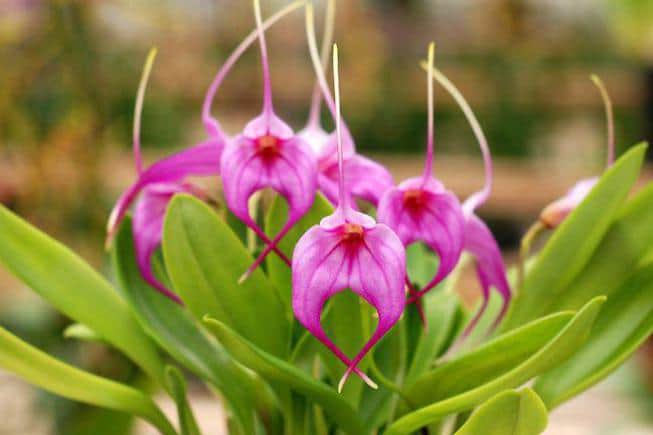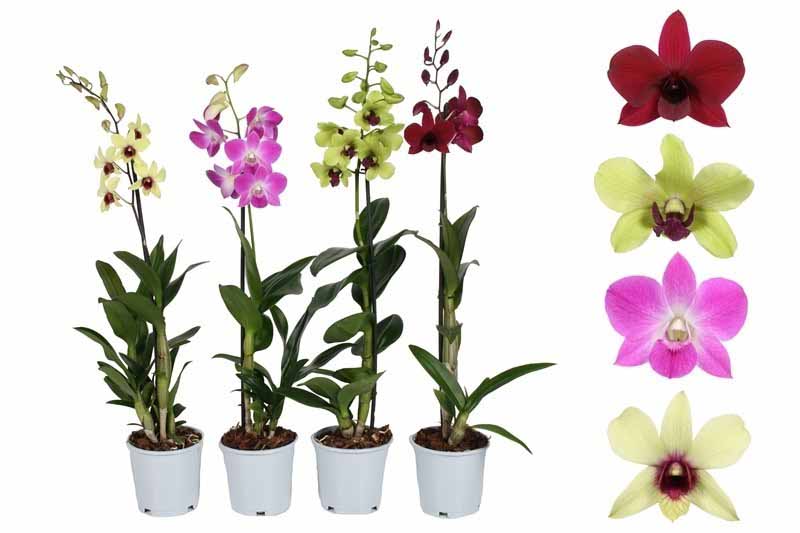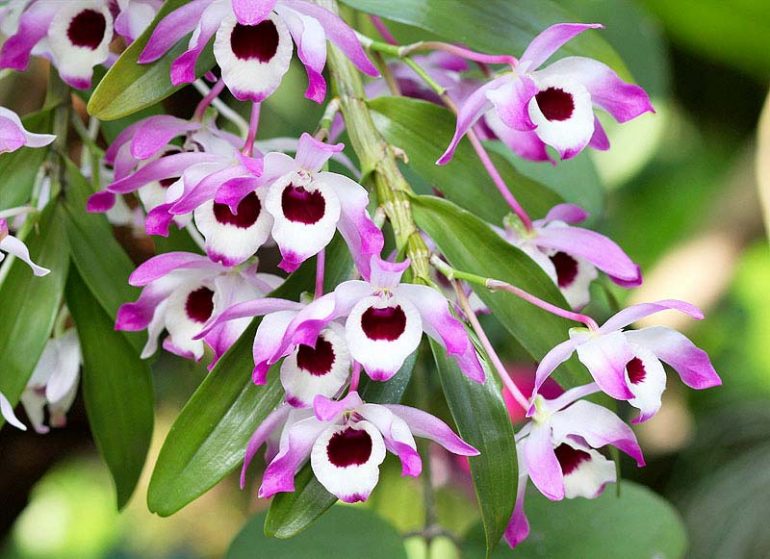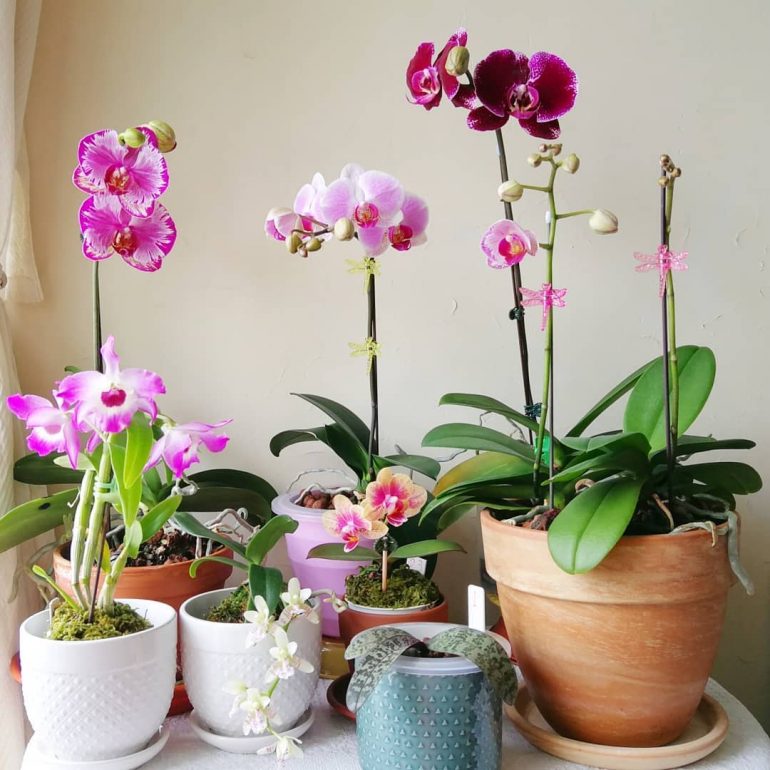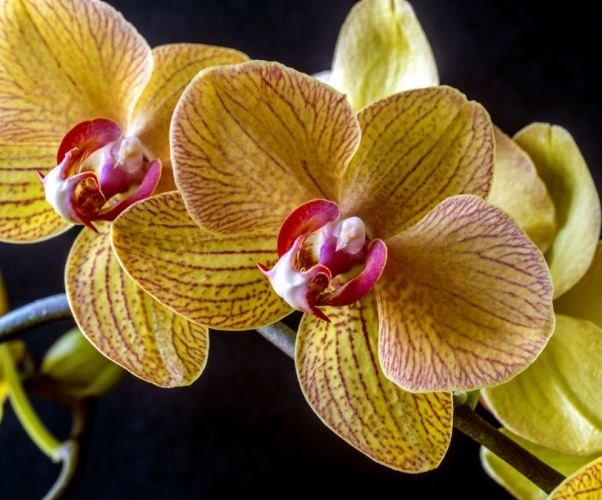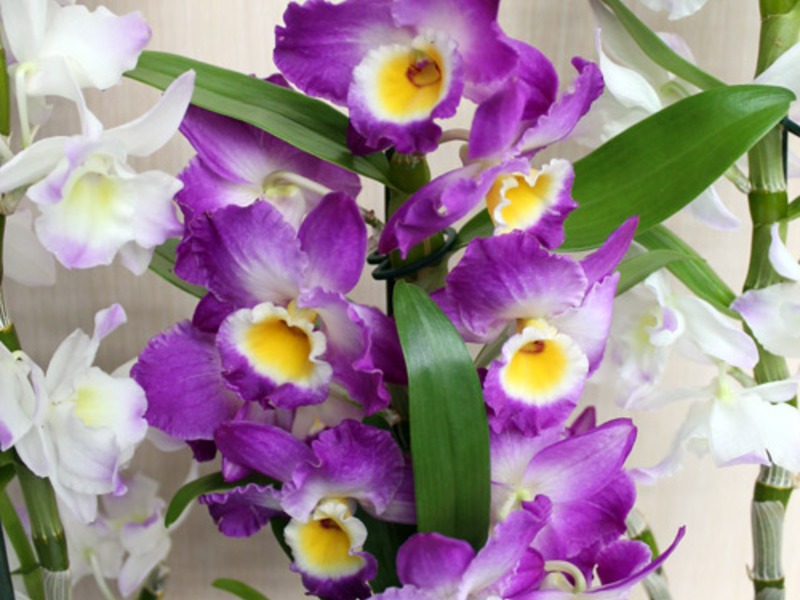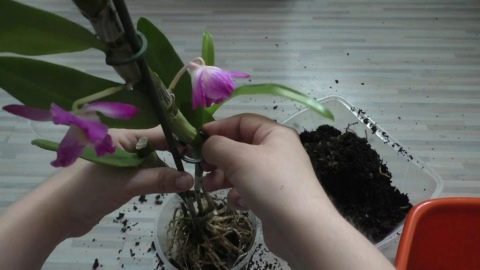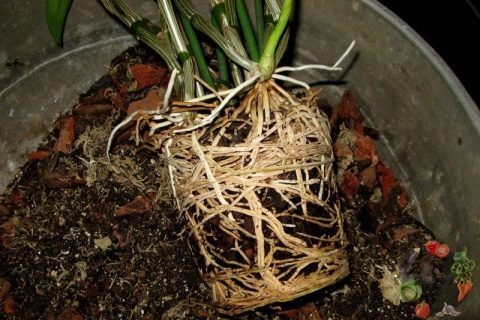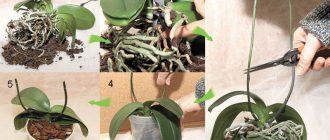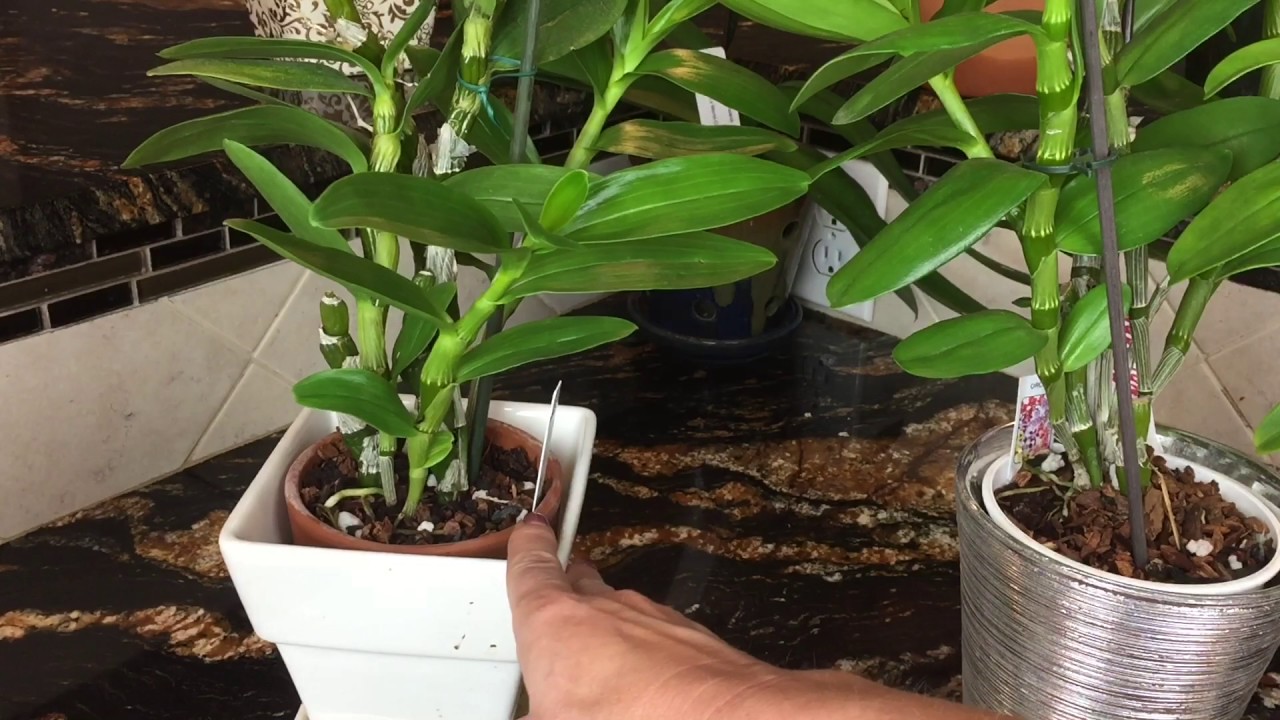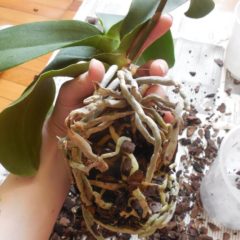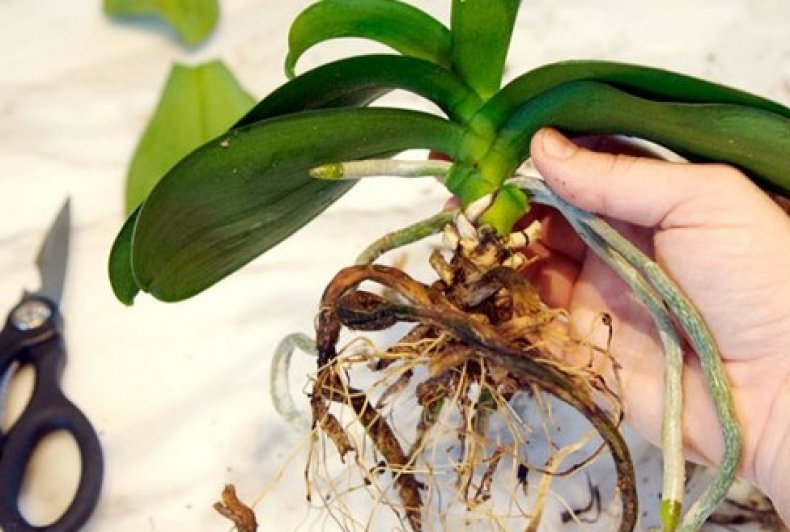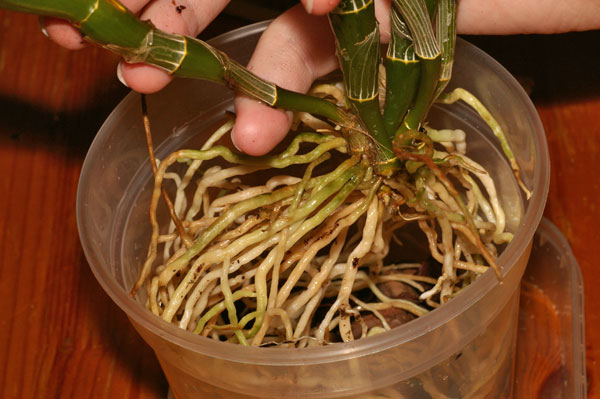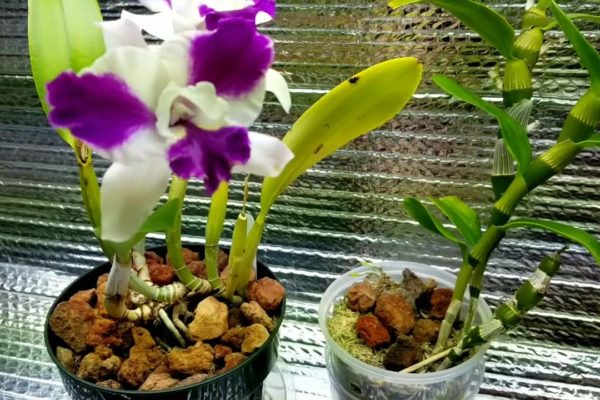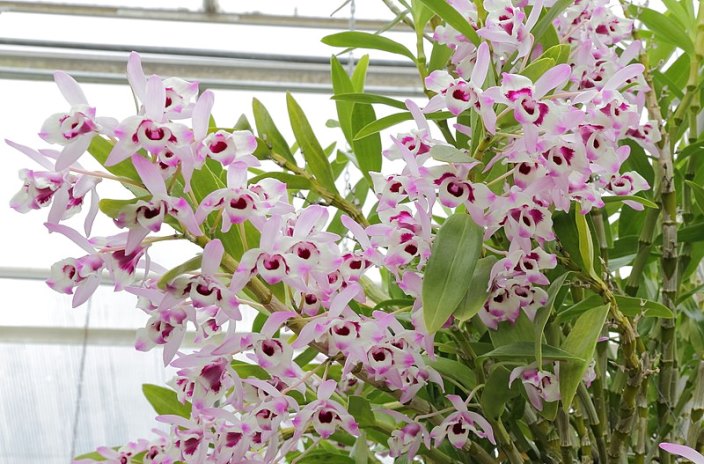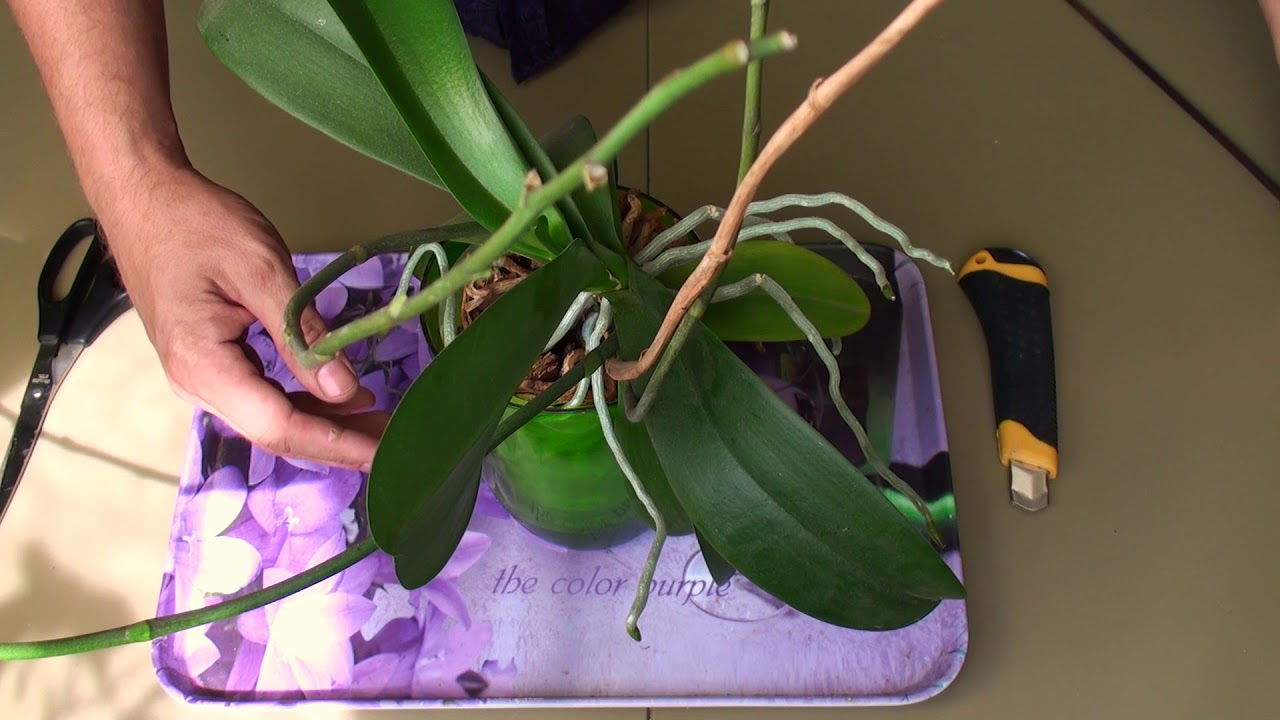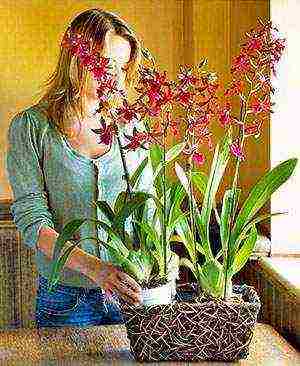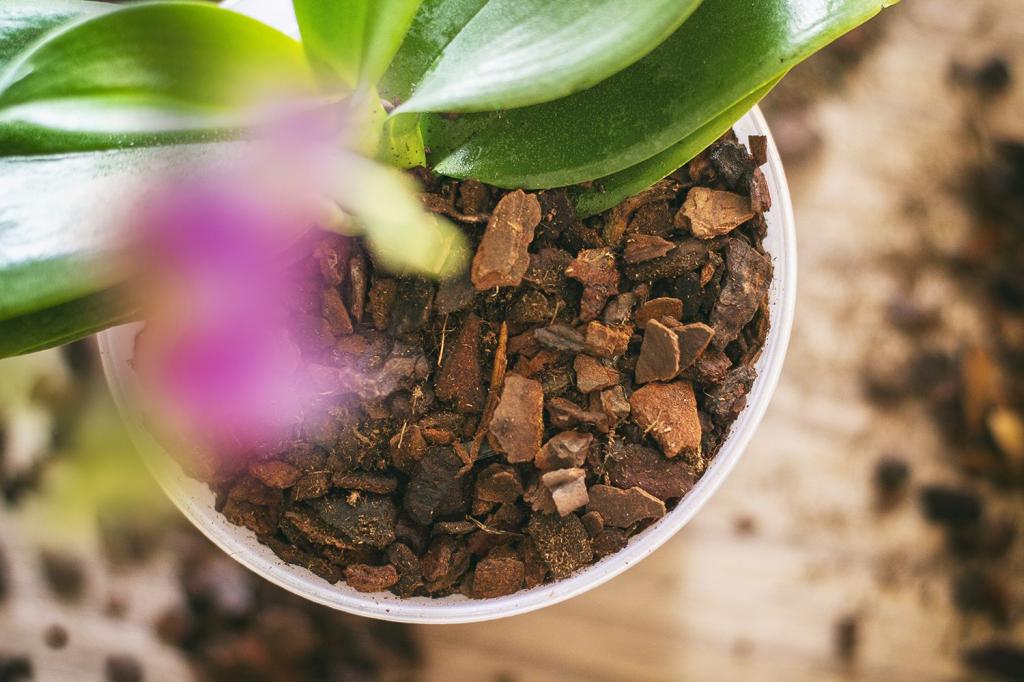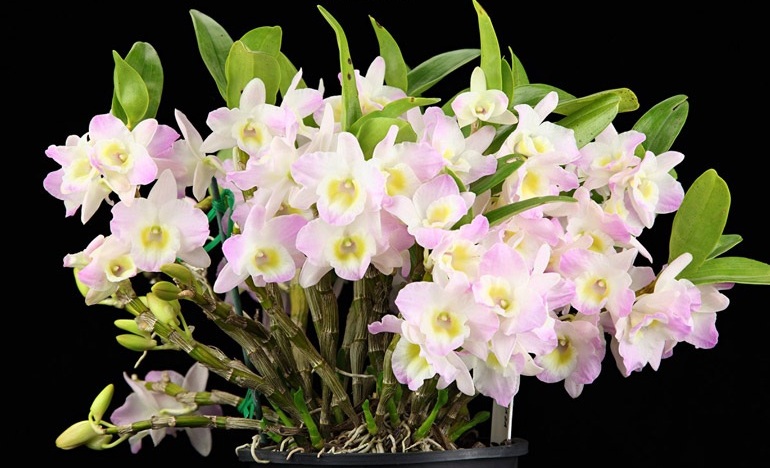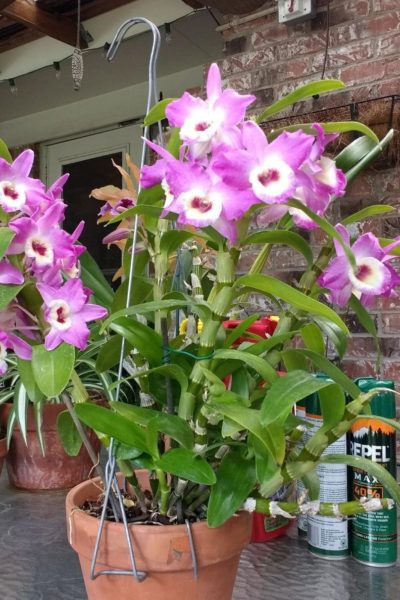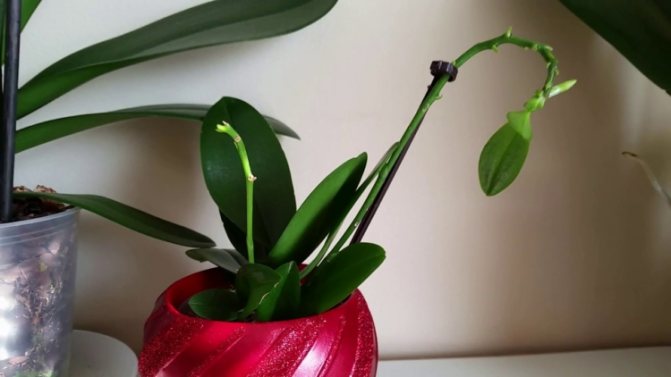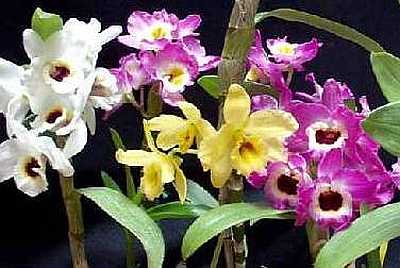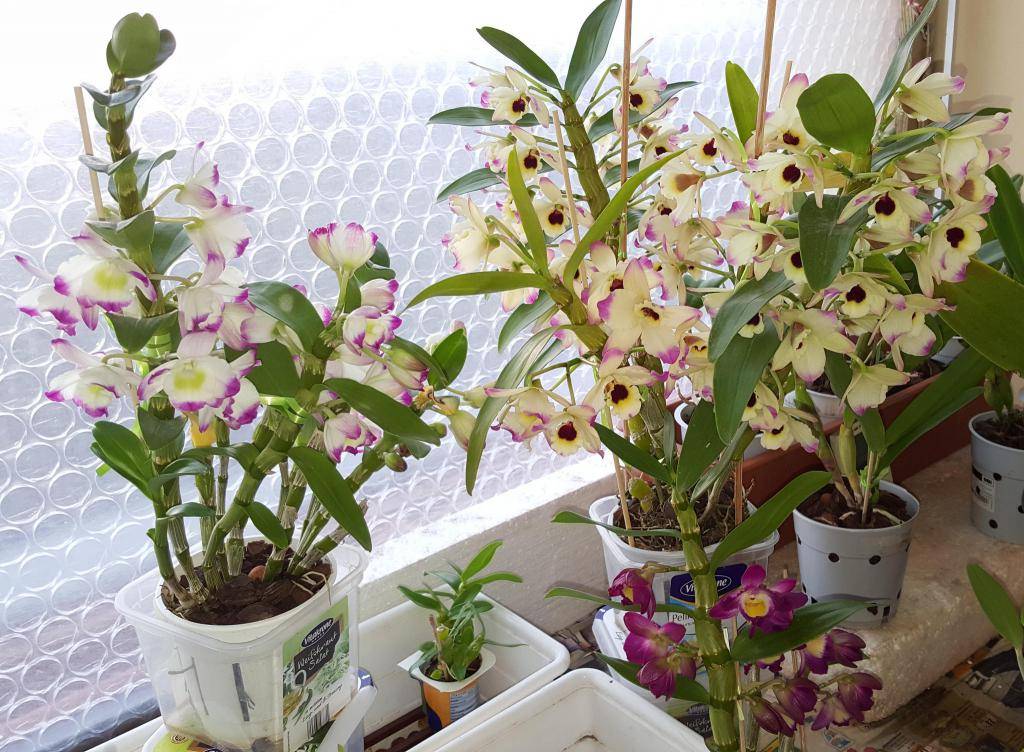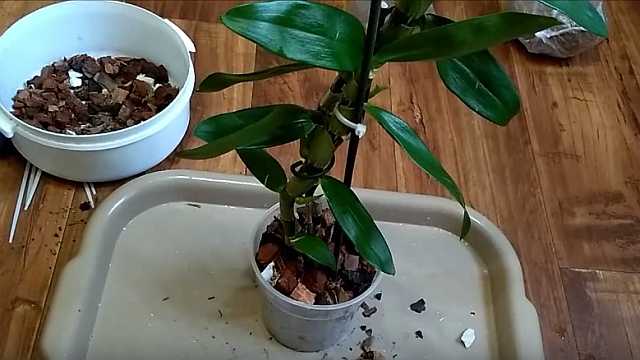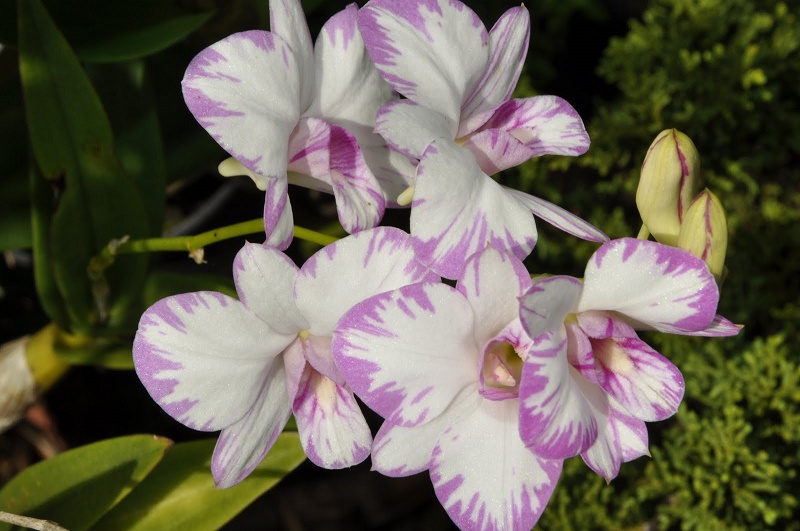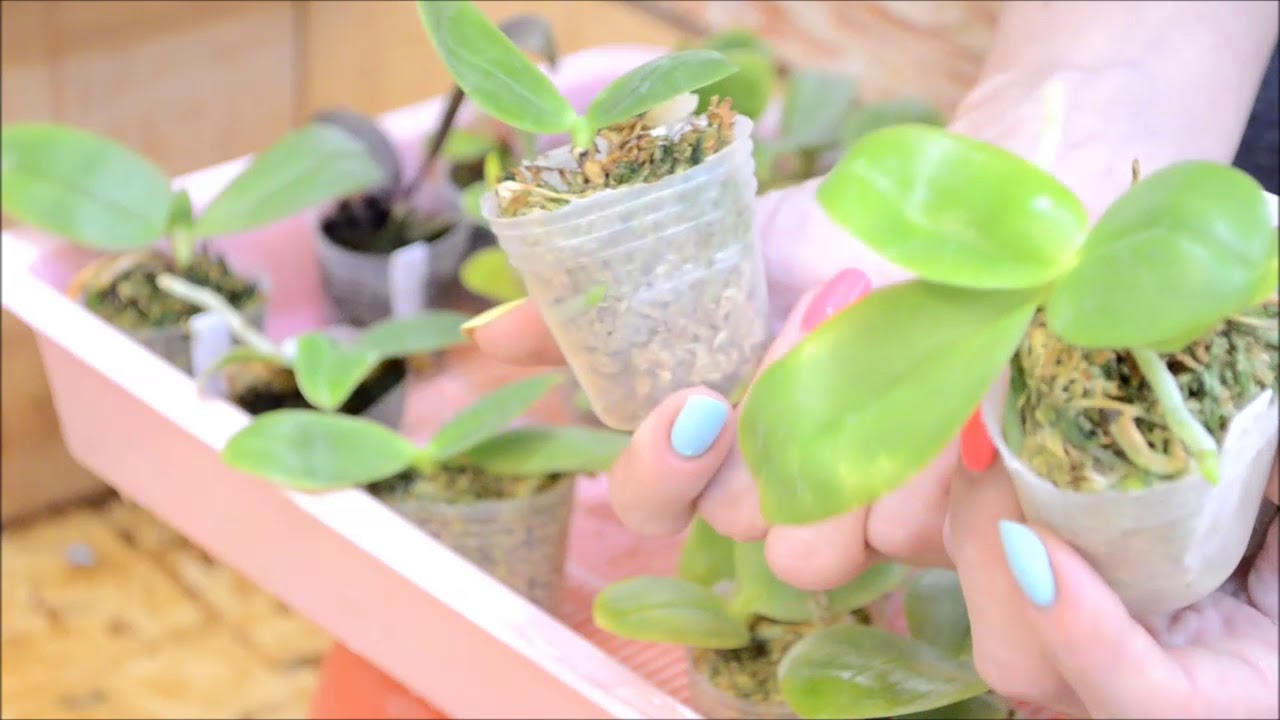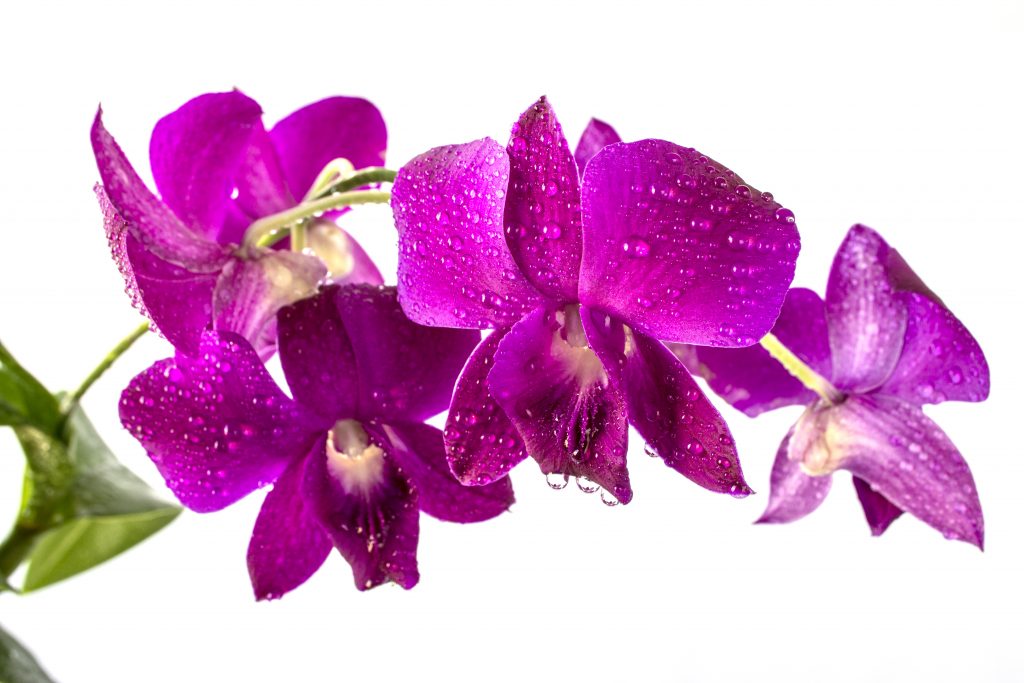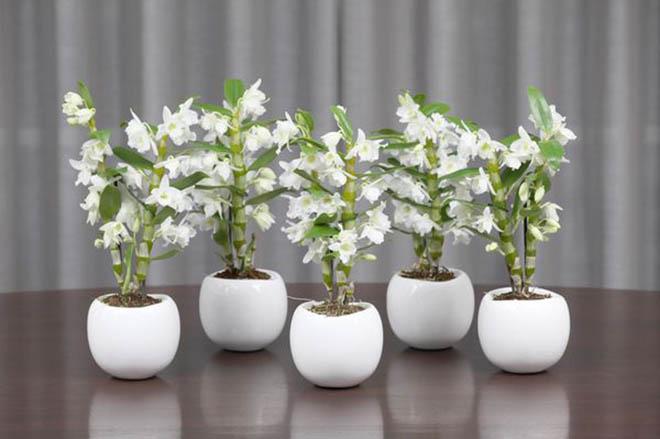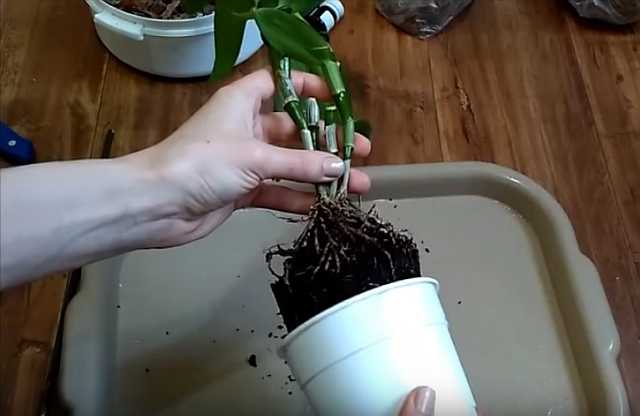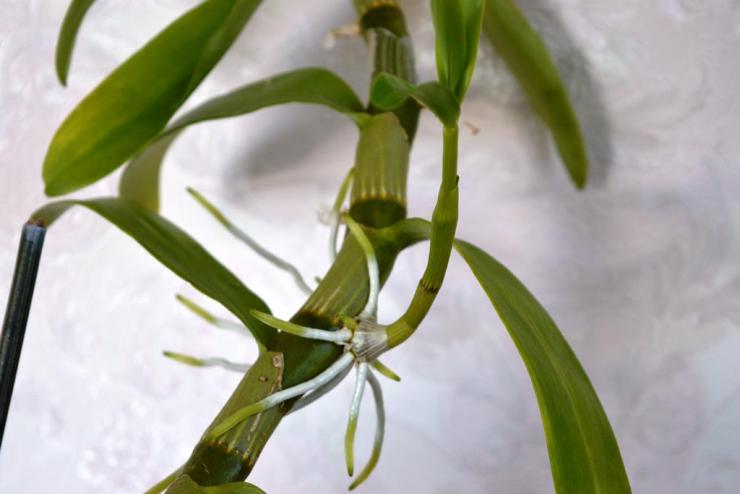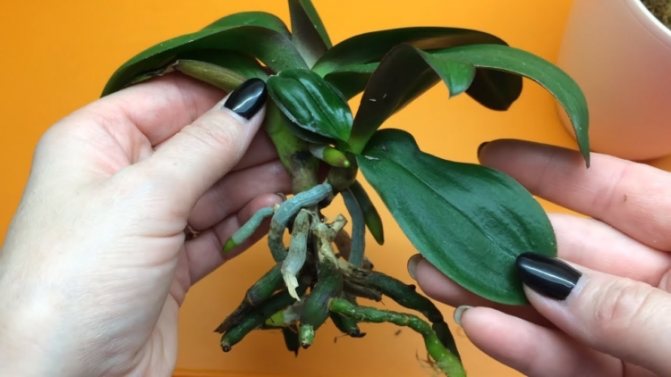How to care for
For a culture to develop normally, it should be provided with full and high-quality care.
Temperature regime
In summer, the optimal daytime temperature is + 20-25 degrees. At night, the indicator should be + 16-21 degrees. In winter, it is not recommended to exceed the daily mark of +20 degrees. At night, the maximum temperature should be +18 degrees. This mode is optimal for thermophilic orchid species.
Illumination
Light requirements vary by orchid variety. Moreover, all varieties love bright diffused light. The flower needs protection from direct sunlight. It should be borne in mind that all species react negatively to the effects of drafts.
Watering mode
In the spring and summer, orchids require abundant watering. In this case, it is recommended to avoid stagnation of liquid in the substrate. This will provoke root rot. For irrigation, it is worth using settled or filtered water.
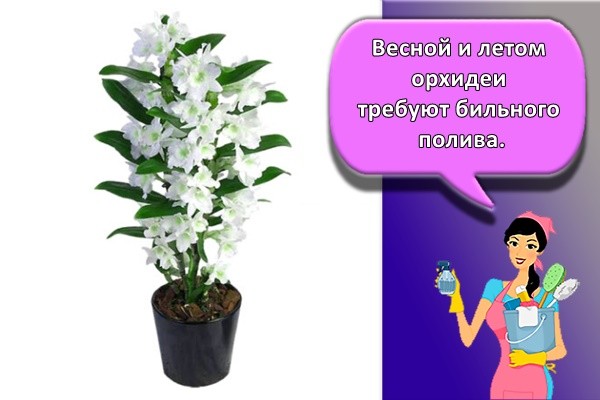
Air humidity
The culture requires high humidity, which should be 50-80%. In summer, it is recommended to keep the plant outdoors and spray its leaves as often as possible. In winter, the container with the culture should be placed on a pallet, which is recommended to be filled with wet gravel.
Transfer
Dendrobium can hardly tolerate transplants. Therefore, this procedure should be performed as rarely as possible - once every 3-4 years. Species that bloom in spring should be replanted immediately after this process is complete. Plants that produce flowers in the fall are moved to a new location at the moment the young shoots begin to develop.
A not too large pot is suitable for a plant. It can be made from any material. A few heavy stones should be placed at the bottom. Organize a drainage layer on top. To do this, it is recommended to use expanded clay or foam.
Then it is worth pouring large bark and carefully transfer the flower into a new pot. The voids are filled with a new substrate. To plant a plant, you should use ready-made soil for orchids.
To plant a plant, you should use ready-made soil for orchids.
Fertilizer and feeding
It is recommended to apply fertilizers only during the period of active growth - from April to September. This procedure is performed every 15 days. To do this, you can use liquid orchid fertilizer. All types of thermophilic dendrobiums require the systematic use of fertilizers based on potassium and phosphorus. This composition is applied once a month. Cool orchids are recommended to be fed with nitrogen 2-3 times a month.
During flowering
The flowering time of orchids is different. Moreover, the duration of this process is 2-3 months. To achieve a timely start of flowering, a difference between night and daytime temperatures of 5-7 degrees is required. The easiest way to achieve this is in the summer.

After flowering
When flowering is over, watering should be gradually reduced. In this case, the peduncle is cut off, and the culture is moved to a cool place. In this case, the culture will be able to fully relax and gain strength. In winter, the bush needs additional lighting. For this, it is certainly recommended to use a phytolamp.
Pot and soil requirements
Dendrobium requires a spacious pot. It should be quite wide. The roots of the plant do not participate in photosynthesis, therefore, it does not require a transparent container. Some epiphytes with flowing flowers are recommended to be planted in hanging baskets.
For a plant, it is worth using a standard substrate, which includes a mixture of sphagnum, peat, pine bark, and charcoal.Before planting, a drainage layer is laid on the bottom of the container, which will help to avoid stagnant moisture.
Step-by-step instruction
Next, we will consider step by step how to plant a plant at home, and also present the rules for transplanting an orchid.
Removing from the pot. First, water the orchid to soften the bark and make it easier to remove from the pot. Same way, before as get a flower, you need to wrinkle the pot a little in your hands or tap it lightly
If you have difficulty, it is best to carefully cut the pot with scissors.
Important: In no case should the roots of the plant be damaged!
Root flushing. In order to remove the old substrate from the roots, it is best to put the orchid in a container of warm water and leave for about 15 minutes or half an hour.
You can also rinse the roots under running water, but care must be taken to ensure that no water gets into the leaf axils.
Inspection of the root system. After rinsing and drying the roots, the orchid must be carefully examined. If pests are found, it is necessary to get rid of them by soaking the plant in warm filtered water, and then treating it with insect repellents. If dry or rotten roots are found, they must be trimmed with sterile instruments, and process the cuts antiseptic.
Removing old leaves. It is necessary to remove all the lower, dry, yellowed and lifeless leaves. You also need to get rid of the soft hollow bulbs. All sections must be treated with a disinfectant.
Drying. You need to dry the orchid for at least 2 hours at an air temperature of + 18-22 degrees, laying it on a clean towel. All places of the cuts should be tightened and dry.
Placing the substrate and plants in the pot. First you need to place drainage on the bottom of the pot, then place the plant in it, covering its roots with a layer of new substrate. It is important to adhere to these rules: The substrate must be evenly distributed over the root system.
You do not need to bury the flower deeply - the growing point should be on the surface.
Also, do not bury the aerial roots of an orchid.
It is not necessary to tamp the soil strongly - after a while the roots will fix themselves in it, but we must not forget that the flower should not hang freely in the pot.
First watering. After completing the transplantation process, the orchid must be removed to a dark place with a temperature of 22-25 degrees. The first watering is carried out after 5 days. When watering, it is necessary to use soft water or water of moderate hardness with acidity in the range of pH 5 and a temperature of 35-40 degrees.
We recommend watching a video about the step-by-step scheme and rules for transplanting an orchid:
Rooting cuttings
- The cuttings are pre-treated with coal.
- Then, 2 cuttings are placed in a plastic bag with moistened sphagnum moss.
- The resulting greenhouse is ventilated every day, mossing the moss if necessary.
- Fresh roots should appear in 2 weeks. Then it's time to plant the cuttings in pots.
Reference. Moving a flower into a larger pot with still suitable land should be carried out by the transshipment method. In this case, the earthen lump is soaked and not completely removed; in a more spacious pot, the voids are filled with fresh soil. The substrate remaining on the roots makes the transplant easier for the orchid.
Shoots of orchids
Where do they appear?
The so-called "baby" transplant method is mainly used for orchids of the genera Phalaenopsis and Dendrobium. The process of a young stem can form on the peduncle, stem, or near the roots of the plant. As a rule, babies are most often formed at the base of the roots or on the peduncle after flowering. It is the second option that is the most common.
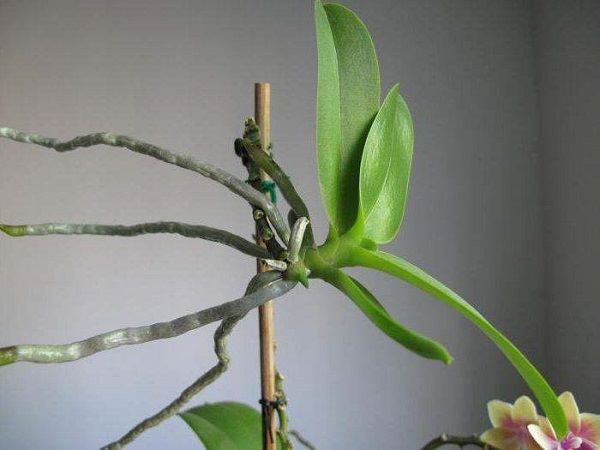
Often babies are formed on the peduncle after flowering.
Stimulating their appearance
So, if the plant is during the dormant period (the main flowering is over), then, subject to certain conditions, it is possible to achieve the formation of a new shoot:
- First of all, it is necessary to remember that the faded peduncle is not completely cut off, but I leave about 2 cm;
- The second condition is to ensure a sufficient level of lighting during this period (in the winter season, special fluorescent lamps are used);
- Another condition for the release of children is a high temperature regime after the flowering of the orchid;
- It is also recommended to reduce the number of waterings (no more than 1 in 5-10 days). You can also use special hormonal drugs that will significantly speed up the process of the formation of children.
Basic ways
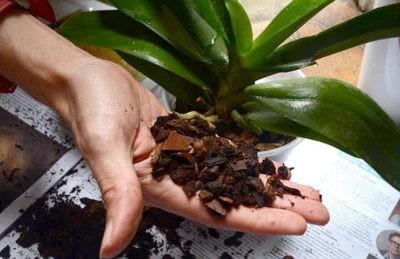 The peculiarities of the Denrobium Nobile orchid are that its roots grow very quickly. Sometimes you have to move the flower to a larger pot. If the orchid is healthy, the roots are not damaged, and the substrate is still suitable, then most often the "transshipment" method is used:
The peculiarities of the Denrobium Nobile orchid are that its roots grow very quickly. Sometimes you have to move the flower to a larger pot. If the orchid is healthy, the roots are not damaged, and the substrate is still suitable, then most often the "transshipment" method is used:
- The earth lump is soaked, disassembled, but not completely removed.
- We clean the roots from damaged dead roots.
- We gently loosen the old substrate, update it.
- We put small pieces of charcoal in it for disinfection.
This method allows you to preserve the earthen ball as the already familiar habitat of the orchid. Adaptation with this method will be less painful and easier. We simply move the flower to a larger pot.
Dividing the bush
We will tell you step by step how to plant a bush at home:
- After flowering, remove the adult orchid from the pot.
- We clean it from the old substrate and damaged roots.
- Cut it into pieces with a sharp processed knife.
- Each part should contain 3 mature healthy pseudobulbs and young shoots, at least 3 cm.
- Place the pieces in water to moisturize.
- We process the sections with charcoal.
- We plant in small pots.
Planting cuttings
- Cut the cuttings 10 cm long with charcoal.
- Put wet moss - sphagnum in plastic bags.
- We place 2 cuttings in each such "greenhouse".
- Store at a temperature of 22 - 24 ºC, daily airing and moisturizing the moss - the base.
- The light is bright, diffused.
- After 2 weeks, when the roots appear, we transplant them into pots.
- Presumably young orchids will bloom in 2 years.
Orchid transplant after purchase
Bringing a flower home, putting it on the windowsill and admiring it, periodically watering - that's not all. The first time you need to look after him carefully. First of all, look at how the leaves or pseudobulbs behave - in these organs, orchids store moisture and nutrients.
A slight loss of turgor is not critical, but if it is caused by not drying the plant, then such a symptom may indicate problems with the roots.
In general, you need to pay attention not to the plant itself, but to how it reacts to your actions. If the reaction is adequate, then everything is fine with the plant, if not, then there are some problems
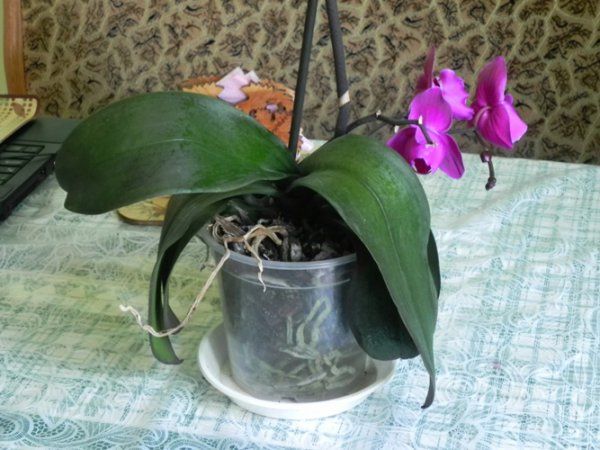
A slight loss of turgor after purchase is normal.
Attention! Withering and discarding of flowers or buds is normal. This is how the plant responds to stress.
But do not worry too much, manufacturers stuff their products with various substances and stimulants that temporarily enhance the immunity of plants. Usually, their actions are enough for the orchid to bloom safely and calmly recover.
Need
A transplant after purchase is necessary and justified only if the orchid is in poor condition and dies. In this case, a complete inspection, pruning of peduncles, dead parts of the plant and other activities is performed. Otherwise, transplant orchids after purchase not necessary.
When can I?
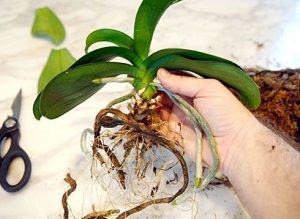 The plant is transplanted only when it literally starts to crawl out of the old pot or the substrate becomes unusable.
The plant is transplanted only when it literally starts to crawl out of the old pot or the substrate becomes unusable.
It should be understood that orchids are only transplanted after flowering. And, accordingly, so how most orchids bloom in winter, the best period for transplanting is in the spring.
It is also the best for the reason that with the onset of spring, daylight hours in the middle lane increase and all plants start growing. Accordingly, your pet will survive the transplant with the least loss.
In principle, with the availability of artificial lighting equipment and appropriate conditions, orchids can be replanted all year round.
Effect of delay on plant development
If you miss the moment when you need to transplant an orchid, then in a too cramped pot and in a deteriorated substrate, the root system of the plant begins to function ineffectively. Naturally, under such conditions, it makes no sense to hope for the normal development of the orchid and, even more so, for its flowering.
Advice! Take care of your plants. They are also living beings.
Causes
There are several reasons for transplants:
- disease. The orchid is removed from the pot, the rotten roots are cut off, procedures are carried out and placed in a fresh substrate;
- the plant has grown. When an orchid outgrows its pot and crawls out of it, this indicates that it is time to increase its "living space";

An overgrown orchid must be transplanted.
- the substrate has collapsed. Most orchids are grown in pine bark substrate. When the bark decomposes and can no longer perform its functions, it is replaced with fresh;
- planned transplant. Every 3-4 years, flower growers transplant their orchids, regardless of the above reasons.
What do you need to remember?
the main thing to know is that orchids have a juicy and very fragile root system
Accordingly, it is important to be extremely careful and careful when handling orchid during transplants so as not to damage her roots;
use an appropriate substrate. For example, phalaenopsis prefer a substrate from only one bark, moreover, a large fraction, while cymbidiums, on the contrary, grow better in a heavier substrate, etc.
You need to pay attention to such moments and not pour everything that comes to hand into the pots with plants;

For different types of orchids, the composition of the soil is slightly different.
watering after transplanting is carried out no earlier than 5 days later. Nothing terrible will happen to the plant if it dries up a little, and the root during this time will have time to safely restore the damage.
Preparation for the procedure. Required tools and materials
The quality of the transplant will directly depend on how seriously you prepare for it. To do this, you need to allocate time (so that all actions can be carried out calmly, without fuss and haste), a place, and also some things.
 Inventory:
Inventory:
- fresh substrate;
- pots of the right size;
- cutting tool (secateurs, sharp knife, scissors or scalpel);
- ground charcoal or cinnamon for filling fresh cuts;
- chemistry (stimulants, fungicides, etc.);
- scoop;
- basin, gloves and oilcloth for convenience;
- good mood - try to have fun.
It is not a fact that all of the above things will be useful to you, but their presence greatly simplifies the work, especially if there are a lot of orchids.
Orchid planting reasons
Orchid planting reasons are planned and emergency. The planned one is the change of the substrate every two to three years (depending on the quality) due to its compaction and decomposition. This allows you to maintain comfortable living conditions for the orchid.
Emergency reasons include the following:
- Soil decomposition, which is transient.
- Decay of the root system.
- The appearance of harmful insects in the substrate.
- The root system does not fit into the pot.
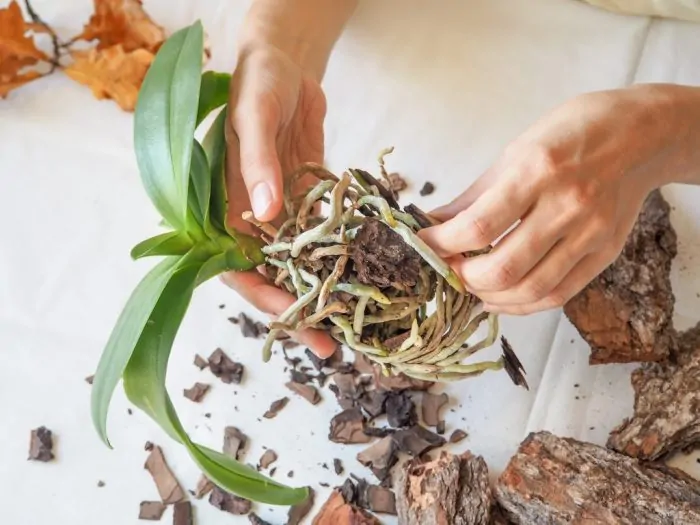
Most store-bought orchids are hybrids. They are adapted for growing at home and can bloom for a long time (up to six months), but they do not have a dormant phase as such. That is why it is difficult to choose the most suitable time for transplantation.Most experts are inclined to believe that plants need to be transplanted in spring (this is the very beginning of the stage of active growth) or after flowering (when the flowers fall off and before budding).
Step-by-step instructions: how to plant an adult plant and children?
Before you start planting children and an adult plant, prepare in advance everything that may come in handy in the process:
- scissors or knife;
- charcoal;
- new pot;
- warm water in a basin;
- orchid substrate.
We have other information about dendrobium on our website. Read about blooming, yellow leaves, and home care.
Removing from the pot
To painlessly get an orchid out of an old pot, you must:
- Wrinkle it with your hands or fill the pot with water up to the top for 10-30 minutes, if the previous steps did not help.
- Then Dendrobium is picked up under the leaves and taken out. The action should happen effortlessly.
Reference. A healthy plant is firmly rooted to each other and to the pot. A weak plant is removed immediately and without effort, due to a weak root system.
Root flushing and disposal of excess substrate
- The rinsing step is best done by immersing the orchid in a bowl of warm water. When the roots and soil are wet, it will be easier to separate them by stirring the root plexus with your fingers. Dirty water must be drained.
- You can use a shower jet with a slight pressure of water.
Strongly ingrown particles of the old substrate should not be forcibly separated from the plant, so as not to damage it.
Examination and removal of diseased processes
Then you should inspect the roots for the presence of:
- pests;
- rot;
- dead areas.
Healthy roots are always firm and dense. Patients are dryish or hollow, sometimes with a liquid, fetid content inside.
Before transplanting, all tools must be disinfected with alcohol or held over a fire to avoid infection of the plant. If this is not done, an infection can occur and the plant will begin to ache.
After removing the damaged parts of the roots, fresh cuts are treated with activated charcoal, garlic solution or cinnamon powder for disinfection.
Drying
Do not ignore the drying step. This helps to heal the wounds resulting from root pruning. In room conditions, it is enough to allocate only 2 hours for this.
Planting a flower and children in new containers
Please note that after pruning the root system, it may turn out that for planting you will need a pot of the same size or even smaller if there are many damaged roots
Important! It is advisable to disinfect the new substrate by boiling before use. Then let it dry naturally without using an oven or battery, so as not to lose its necessary qualities.
The pot is also washed with hot water and detergent, followed by rinsing.
Then let it dry naturally without using a stove or battery, so as not to lose its necessary qualities. The pot is also washed with hot water and detergent followed by rinsing.
Important! It is advisable to disinfect the new substrate by boiling before use. Then let it dry naturally without using an oven or battery, so as not to lose its necessary qualities.
The pot is also washed with hot water and detergent followed by rinsing.
- A small drainage layer of expanded clay is laid out at the bottom of the pot.
- Then some mixture.
- The plant is placed in the center and the empty space around it is filled with the rest of the mixture.
- When sprinkling with substrate, you need to make sure that the roots do not move to one place if the old soil has been removed completely.
- The soil is slightly crushed.
Diseases and pests
Dendrobium orchid often falls prey to various diseases. For example, the leaves turn yellow or become stained, the shape of the flowers themselves changes, and sometimes the buds, in principle, do not open.In the latter case, the plant cannot be treated and can only be thrown away. Such symptoms are most often characteristic of viral diseases. In the case of bacterial diseases, individual parts of the orchid are affected by spots and rot, and sometimes fungi.
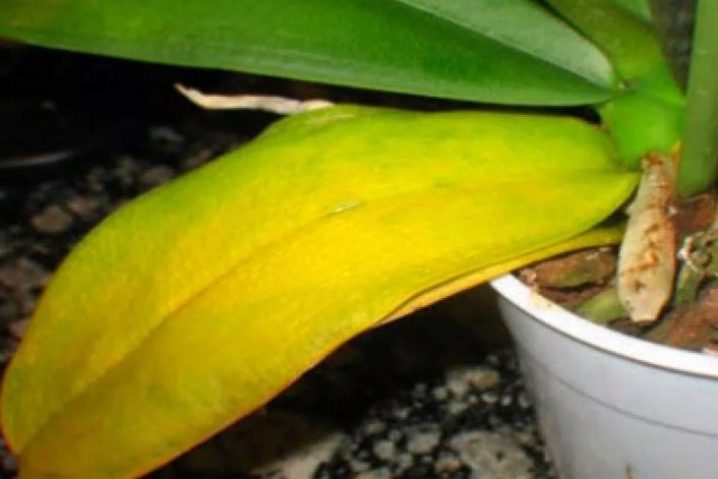
In this case, the orchid is separated from other plants in the room and freed from the affected parts by simply cutting them off. Cutting points are treated with ordinary brilliant green or disinfectant
It is important to carry out a similar procedure as soon as symptoms of the disease have been noticed. After treating dendrobium, it will have to be quarantined and tracked whether spots or other manifestations return
If everything is in order, then you can return it to your "neighbors".

Yellowing leaves can be both a symbol of a bacterial disease, and a natural transition from one period of the cycle to another. For example, after the completion of flowering, the orchid needs time for further preparation - it is then that the leaves turn yellow. After that, the growth of new shoots and the root system begins. However, most often the yellow color appears due to improper irrigation or lack of nutrients in the soil mixture. When the yellow color appears in the form of specks and does not completely cover the leaf, it is probably a burn caused by direct sunlight.

Of the pests, the orchid is most often attacked by thrips, aphids and spider mites. Sometimes this happens due to too dry air, which means that it is eliminated by the introduction of regular spraying and other measures to increase humidity. For prevention purposes, it is better to treat dendrobium every two weeks with ordinary soapy water. A small number of insects can be eliminated simply by removing them from the sheets with a wet piece of cotton wool.
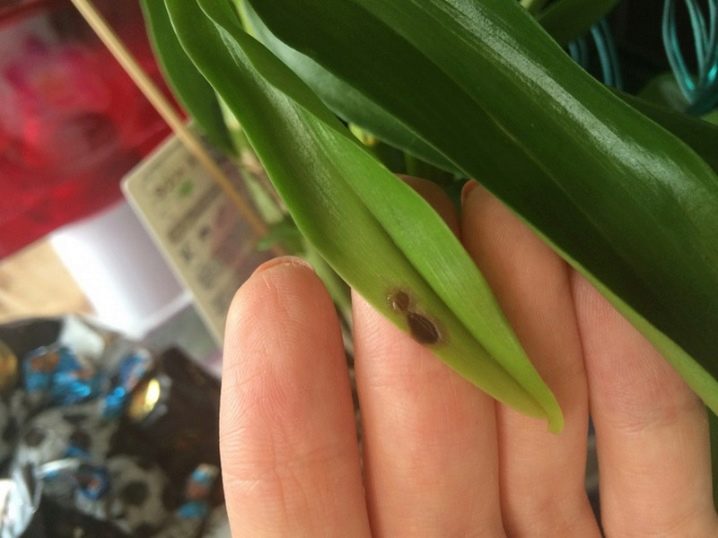
For information on how to care for a dendrobium orchid at home, see the next video.
Flowering features
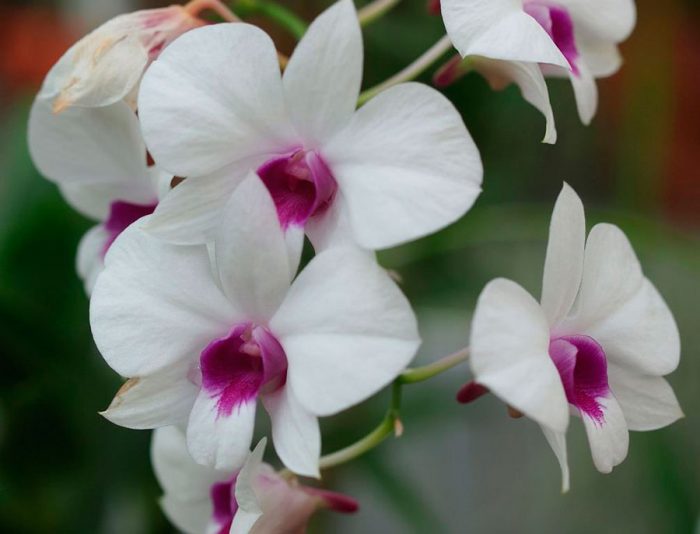
Care rules during flowering
Each type of dendrobium orchid blooms in its own time, while the duration of flowering can range from 2 to 3 months. In order for the plant to bloom in a timely manner, a temperature difference of 5-7 degrees at night and during the day is recommended. The easiest way to achieve this is in the summer, and in winter, the matter is complicated by round-the-clock heating of the premises.
When growing dendrobium nobile in winter, in order to make it bloom, some growers resort to an unusual method. They don't water the bush untiluntil new growth appears. When this growth in height reaches 20-30 mm, and it grows its own roots, the watering of the flower is resumed. After the growth is equal to the old bulbs, a gradual reduction of watering is carried out until it stops completely, while the temperature is reduced to 12 degrees. Watering is resumed only when the formed buds begin to bloom, otherwise children will develop instead of flowers.
orchid DENDROBIUM after flowering and HOW TO MAKE FLOWERS Dendrobium nobile
Post-flowering care
After the flowering is over, they begin to gradually reduce watering until it stops completely, the peduncle is cut off, and the bush itself is transferred to a place where it is always cool. In this case, he will be able to have a good rest and gain strength before a new flowering. Dendrobium growing in nature does not stop growing even in winter, however, in mid-latitudes during the cold season, due to poor lighting, it hibernates, at which time its growth stops. Of course, he will not die from this, but experts do not recommend this to be allowed. In winter, when the daylight hours are very short, the bush must be supplemented with additional lighting, and it is best to use a phytolamp for this. The fact is that an orchid growing in nature does not have a dormant period, it is constantly busy with something, as a rule, the flower grows either foliage, or roots, or peduncles. If your flower goes into hibernation in the autumn, then you should not disturb it.In this case, watering is temporarily stopped and the bush is transferred to a cool place.



